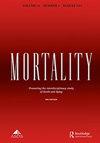死亡原因:杀害女性
IF 0.7
0 HUMANITIES, MULTIDISCIPLINARY
引用次数: 1
摘要
针对妇女的暴力行为被联合国妇女署称为“阴影流行病”,在2020-21年期间受到了全球公众的广泛关注。在这一公众关注的时刻,在记录全球对妇女的暴力行为的性质和开展反对运动方面有着悠久的历史。在杀害妇女问题上也是如此。虽然我们认识到这是一个有争议的术语,但出于本文的目的,我们使用弑女罪来指因女性而被男性暴力杀害的妇女和女孩。杀害妇女作为一种应在法律上具体计算的死亡,只存在于少数司法管辖区。在被认为是杀害女性的地方,主要是在南美国家,这种死亡只是全球此类杀戮的冰山一角。本文利用了2020年收集的一系列不同来源的经验数据(包括行政数据、媒体分析和杀害女性观察站的数据),考虑了以下问题:所谓的“杀害女性”意味着什么,如果所有死于男性之手的女性都被算作杀害女性,可能会产生什么影响,以及特殊时期对这种普通死亡的影响程度。本文章由计算机程序翻译,如有差异,请以英文原文为准。
Cause of death: femicide
ABSTRACT Labelled ‘the shadow pandemic’ by UN Women, violence against women received considerable global public attention during 2020–21. Underpinning this moment of public concern, there lies a substantial history of efforts to document the nature of, and campaign against, the extent of violence against women globally. This is also the case in relation to femicide. Whilst we recognise that this is a contested term, for the purposes of this paper we use femicide to refer to the killing of women and girls because they are female by male violence. Femicide, as a death to be specifically counted in law only exists in a small number of jurisdictions. Where it is so recognised, primarily in South American countries as feminicidio, such deaths represent only the tip of the iceberg of such killings globally. This paper, in drawing on empirical data from a range of different sources (including administrative data, media analysis, and Femicide Observatory data) gathered throughout 2020, considers: what it means to call a death femicide, what implications might follow if all the deaths of women at the hands of men were counted as femicide, and the extent to which extraordinary times have any bearing on this kind of ordinary death.
求助全文
通过发布文献求助,成功后即可免费获取论文全文。
去求助
来源期刊

Mortality
Arts and Humanities-Religious Studies
CiteScore
1.80
自引率
12.50%
发文量
42
期刊介绍:
A foremost international, interdisciplinary journal that has relevance both for academics and professionals concerned with human mortality. Mortality is essential reading for those in the field of death studies and in a range of disciplines, including anthropology, art, classics, history, literature, medicine, music, socio-legal studies, social policy, sociology, philosophy, psychology and religious studies. The journal is also of special interest and relevance for those professionally or voluntarily engaged in the health and caring professions, in bereavement counselling, the funeral industries, and in central and local government.
 求助内容:
求助内容: 应助结果提醒方式:
应助结果提醒方式:


